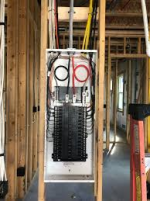Bahnsen
Member
- Location
- West Pennsylvania
- Occupation
- Engineer
I'm running aluminum 4/0 SER up my 2x4 wall. Because the cable is 1.5" in diameter, even if placed in the centerline of the 2x4 stud it doesn't comply with the NEC requirement of 1 1/4". I know that NEC 300.4 D specifies that a steel "sleeve" that is 1/6" thick serves as protection. My question is, can I use EMT (of an appropriate fill size for the wire) as a "sleeve" between the top and bottom plate of the wall to protect that portion (I understand that the wire also needs to be protected where it passes through the top/bottom plates). If so, do I have to install bushings on the ends of the EMT even though I don't really see damage occurring since the EMT would be strapped in place (not possible of moving) and the wire wouldn't really be exposed to the edges of the tubing since it still has to pass through the upper and lower wall plates. Thoughts?
Thanks,
Matt
Thanks,
Matt



